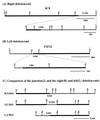Analysis of fusion junctions of circularized chromosomes in Streptomyces griseus
- PMID: 10482512
- PMCID: PMC94091
- DOI: 10.1128/JB.181.18.5711-5717.1999
Analysis of fusion junctions of circularized chromosomes in Streptomyces griseus
Abstract
A filamentous soil bacterium, Streptomyces griseus 2247, carries a 7. 8-Mb linear chromosome. We previously showed by macrorestriction analysis that mutagenic treatments easily caused deletions at both ends of its linear chromosome and changed the chromosome to a circular form. In this study, we confirmed chromosomal circularization by cloning and sequencing the junction fragments from two deletion mutants, 404-23 and N2. The junction sequences were compared with the corresponding right and left deletion end sequences in the parent strain, 2247. No homology and a 6-bp microhomology were found between the two deletion ends of the 404-23 and N2 mutants, respectively, which indicate that the chromosomal circularization was caused by illegitimate recombination without concomitant amplification. The circularized chromosomes were stably maintained in both mutants. Therefore, the chromosomal circularization might have occurred to prevent lethal deletions, which otherwise would progress into the indispensable central regions of the chromosome.
Figures







Similar articles
-
Circularized chromosome with a large palindromic structure in Streptomyces griseus mutants.J Bacteriol. 2004 Jun;186(11):3313-20. doi: 10.1128/JB.186.11.3313-3320.2004. J Bacteriol. 2004. PMID: 15150216 Free PMC article.
-
Chromosomal circularization in Streptomyces griseus by nonhomologous recombination of deletion ends.Biosci Biotechnol Biochem. 2003 May;67(5):1101-8. doi: 10.1271/bbb.67.1101. Biosci Biotechnol Biochem. 2003. PMID: 12834288
-
Chromosomal deletions in Streptomyces griseus that remove the afsA locus.Mol Gen Genet. 1997 Jan 27;253(4):478-83. doi: 10.1007/s004380050346. Mol Gen Genet. 1997. PMID: 9037108
-
Genetic instability of the Streptomyces chromosome.Mol Microbiol. 1998 Jan;27(2):239-46. doi: 10.1046/j.1365-2958.1998.00652.x. Mol Microbiol. 1998. PMID: 9484880 Review.
-
[Dynamic structural changes of the linear chromosomes of streptomyces and the origin and evolution of chromosomes].Tanpakushitsu Kakusan Koso. 1998 Sep;43(11):1453-60. Tanpakushitsu Kakusan Koso. 1998. PMID: 9760842 Review. Japanese. No abstract available.
Cited by
-
Two chimeric chromosomes of Streptomyces coelicolor A3(2) generated by single crossover of the wild-type chromosome and linear plasmid scp1.J Bacteriol. 2004 Oct;186(19):6553-9. doi: 10.1128/JB.186.19.6553-6559.2004. J Bacteriol. 2004. PMID: 15375137 Free PMC article.
-
Circularized chromosome with a large palindromic structure in Streptomyces griseus mutants.J Bacteriol. 2004 Jun;186(11):3313-20. doi: 10.1128/JB.186.11.3313-3320.2004. J Bacteriol. 2004. PMID: 15150216 Free PMC article.
-
Chromosomal instability in Streptomyces avermitilis: major deletion in the central region and stable circularized chromosome.BMC Microbiol. 2010 Jul 26;10:198. doi: 10.1186/1471-2180-10-198. BMC Microbiol. 2010. PMID: 20653985 Free PMC article.
-
Chromosomal arm replacement in Streptomyces griseus.J Bacteriol. 2003 Feb;185(3):1120-4. doi: 10.1128/JB.185.3.1120-1124.2003. J Bacteriol. 2003. PMID: 12533491 Free PMC article.
-
Cloning and analysis of the telomere and terminal inverted repeat of the linear chromosome of Streptomyces griseus.J Bacteriol. 2002 Jun;184(12):3411-5. doi: 10.1128/JB.184.12.3411-3415.2002. J Bacteriol. 2002. PMID: 12029061 Free PMC article.
References
-
- Altenbuchner J, Cullum J. Structure of an amplifiable DNA sequence in Streptomyces lividans 66. Mol Gen Genet. 1985;201:192–197. - PubMed
-
- Chater K F, Hopwood D A. Streptomyces. In: Sonenshein A L, Hoch J A, Losick R, editors. Bacillus subtilis and other gram-positive bacteria: biochemistry, physiology, and molecular genetics. Washington, D.C: American Society for Microbiology; 1993. pp. 83–99.
Publication types
MeSH terms
Substances
LinkOut - more resources
Full Text Sources
Miscellaneous

